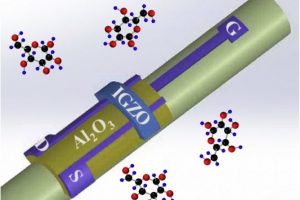Researchers at the Tokyo Institute of Technology have found a novel way to reduce source and drain contact resistance, and increase carrier mobility, in amorphous oxide transistors. In particular, they are amorphous indium gallium oxide (a-IGZO) thin-film transistors that are being proposed for a form of DRAM, where memory density can be increased by stacking the transistors. The problem is ...
Tag Archives: IGZO
More on: Thin-film source-gated transistor promises denser circuits
Announced yesterday, researchers from Surrey and Cambridge universities and the National Research Institute in Rome have used thin-film source-gated transistor (SGT) to create compact analogue circuit building blocks that can be used on flexible substrates. Source-gated transistors – SGTs – are uni-polar – they only need n or p-type semiconductor, not both. The research team built two two-transistor building blocks: ...
Oxide transistor printed around 2mm tube, for medical diagnosis
Transparent transistors have been fabricated around glass tubes of 2mm diameter, at Oregon State University. It replaces a polymer transistor, printed on film and wrapped around the tube, which fell apart when tested as part of an artificial pancreas – a catheter intended to detect blood sugar levels and transmit the information to a wearable insulin pump for diabetics. Key ...
Manchester thin-film oxide transistor hits 1GHz
The University of Manchester has made a 1GHz thin-film transistor from amorphous IGZO – indium gallium zinc oxide. The devices, created with Shandong University in China, are made on a high-resistance silicon substrate using Ta2O5 gate dielectric. The material is 80% transparent, opening the door to display applications. “Making a high performance device, like our GHz IGZO transistor, is challenging because ...
 Electronics Weekly Electronics Design & Components Tech News
Electronics Weekly Electronics Design & Components Tech News



